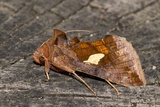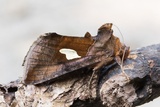Autographa bractea ([Denis & Schiffermüller], 1775) Species
Last modified: Nov. 12, 2025, 8:35 p.m.
First observation of this species in Belgium was 1940 and it is an irregular and very scarce migrant in the north. More observations in the south and southeast of Belgium, especially in damp places and moors located in conifer forests, but also there very rare and local.
Details
- Classification
- Family: Noctuidae > Subfamily: Plusiinae > Tribus: Plusiini > Genus: Autographa > Species: Autographa bractea
- Vernacular names
- Zilvervenster (NL), Gold Spangle (EN), La Feuille d'or (FR), Quellhalden-Goldeule (DE)
- First mention in Belgium
- Berger L. A. 1945a. Espèces nouvelles pour la faune belge. — Lambillionea 45: 1–2, 9–10. On page 2.
- Status
-
Migrant In Belgium since July 1940.
Distribution
Bionomics
It overwinters as a larva and pupates in late spring in a cocoon formed under a leaf of the food plant in late spring.
The species can be seen by day and by night and can be attracted to light and sugar.
Flight periods
The adults fly in one generation a year and have been observed from end of June till the end of October, but mainly during July and August.
Observed on
- Host plant (genera):
- Urtica, Senecio, Hieracium, Eupatorium, Vaccinium, Lonicera and Glechoma
- Substrates:
- Herbaceous plants
The larva lives on a wide variety of herbaceous plants such as Urtica, Senecio, Hieracium and Eupatorium.




